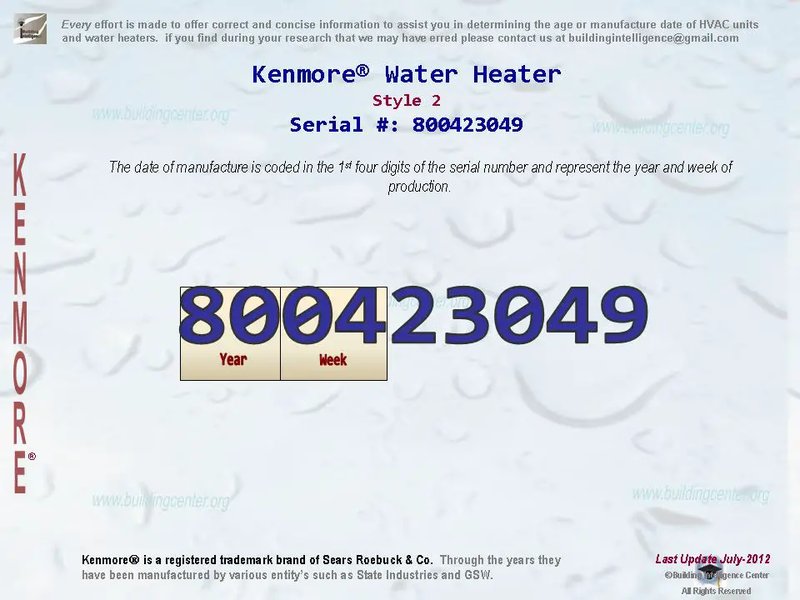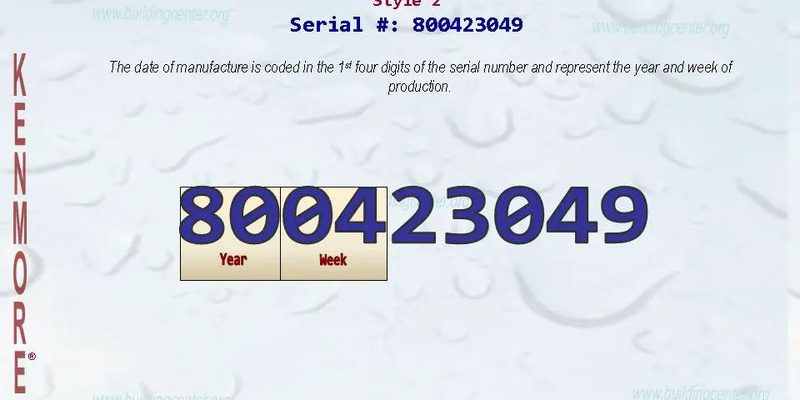
Let me explain: Kenmore water heaters, like most appliances, use serial numbers as their fingerprints. Every unit gets a unique code stamped somewhere on its body. This number tells you when and where your unit was made—and, more importantly, if it’s covered by warranty. It might sound technical, but finding this serial number is usually straightforward once you know what to look for. Let’s walk through the process together, step by step, so you can avoid unnecessary headaches (and long customer service calls).
Why the Serial Number Matters for Warranty Claims
Here’s the thing about warranties—without the serial number, your claim is basically dead in the water. The Kenmore brand, like many others, uses the serial number to confirm everything about your water heater: its model, manufacturing date, and eligibility for coverage. Honestly, it acts as a backstage pass to the support you deserve.
When you call in for help, Kenmore or Sears will ask for this number right away. Without it, they can’t even start syncing up your product details in their system. Imagine trying to reset a universal remote without knowing the right code—it’s frustrating, and there’s no real progress. This is why locating that serial number is so critical for troubleshooting any issues or activating warranty support.
It’s also worth noting that the length of warranty coverage can vary based on your heater’s age and model. The serial number holds the key to all these details. So, if you want to avoid being sent in circles or having your request denied, make sure you know exactly where that number hides on your unit.
Common Serial Number Locations On Kenmore Water Heaters
Now, let’s get practical. You might be wondering, “Where do I even start looking?” Well, water heaters aren’t exactly tiny, and their labels can end up in some unexpected spots. But in most cases, Kenmore keeps things pretty standard.
- First, check the side of your water heater near the bottom. There’s usually a big sticker or metal plate with manufacturer info, including the brand, model number, and—yes—the serial number.
- Sometimes, the label gets placed closer to the top or around the back, near where the pipes connect. Don’t be afraid to use a flashlight or snap a picture with your phone if the spot’s hard to reach.
- If your heater sits in a closet or tight space, you might need to move a box or two. Just watch your knuckles—there’s nothing like a mystery scrape when you’re halfway through a DIY project.
Pro tip: If your unit has any outer jackets or covers, check underneath or behind them. That label isn’t going to jump out and wave at you, but it also won’t be hidden like some secret code. Usually, it’s in plain sight—just at an angle you might not expect.
Decoding the Serial Number: What Do All Those Digits Mean?
You found the serial number—great! But now it looks like a cryptic password, packed with numbers and letters. Decoding it isn’t as tough as it seems, and doing so can tell you exactly when your Kenmore water heater was made. This info comes in handy for warranty checks, reset support, or even general troubleshooting.
Typically, Kenmore water heater serial numbers include:
- Year and week of manufacture (often the first four digits)
- Manufacturer code (tells you which company actually made your heater—Kenmore sources from several suppliers)
- Unique item number
For example, let’s say your serial number is 1634123456. The “16” might mean it was made in 2016, the “34” is the 34th week of that year, and the rest identifies your specific unit. Once you have this code, you can easily pair your warranty details by calling the support line. If you ever need to sync this with the support database, those are the digits you’ll need.
Manufacturers sometimes change formats, so don’t worry if your number doesn’t fit this exact template. The main goal is to find the full string listed under “Serial Number”—not the model or part number.
Steps To Find And Use Your Serial Number For Warranty
Let’s break down the process so it doesn’t feel overwhelming. Here’s exactly how you can locate and use your Kenmore water heater serial number for a warranty claim:
- Step 1: Grab a flashlight and your phone (for pictures if needed).
- Step 2: Inspect the tank, starting with the side near the bottom, then check higher up or around the back if you don’t spot it right away.
- Step 3: Look for a sticker or metal plate labeled “Serial Number.” Take a clear photo for reference.
- Step 4: Copy the serial number exactly—don’t mix it up with model or code numbers.
- Step 5: Contact Kenmore (or Sears) warranty support. Be ready to provide your purchase info, the serial number, and a quick description of your problem.
If you run into trouble—like the label is missing or unreadable—don’t panic. Customer support can sometimes help you pair your proof of purchase and reset your registration with them. However, having that serial number makes the process way smoother.
What To Do If The Serial Number Is Missing or Damaged
You might open that closet or basement door, inspect your Kenmore water heater, and…nothing. No label. Or maybe it was wiped clean by years of drippy pipes or basement dust. This happens more often than you’d think, especially in older units.
If the sticker’s gone, try these troubleshooting moves:
- Check your original user manual or purchase documents. Sometimes, the installer writes the number there when they sync up paperwork.
- Look for older warranty cards—if you registered your unit when new, the serial code is usually printed there.
- If all else fails, call Kenmore or Sears customer service. Give them the model number, installation address, and your best guess on the purchase date. They may be able to pair your info with their system or suggest a reset for your registration process.
Just remember, for water heater warranty claims, having a clear serial number is like having the right code for a remote—it’s what makes the whole system work. Without it, things get complicated, but patience and good record-keeping usually save the day.
Comparing Kenmore Serial Numbers To Other Brands
You might be curious—do all water heater brands use the same serial number system as Kenmore? Honestly, not quite. While the principle is the same (a unique code, stamped somewhere semi-obvious), layout and details often vary.
For example:
- Rheem water heaters often have their serial number sticker right on the front, but their format can look different—a mix of letters and numbers that’s tough to decode without a chart.
- AO Smith uses a similar system, but sometimes their codes include details like plant location or even specific batch numbers. That means a universal lookup doesn’t always work—you need the brand’s support to translate it.
- With Kenmore, the process is a bit more streamlined because Sears maintains most records. But remember, because Kenmore sources from several manufacturers, the exact sticker location and format might change, even between models that look almost identical.
If you’re jumping between brands or dealing with a universal support team, always double-check that you’re not mixing up the model, part, or code numbers. Each brand speaks its own “serial language,” so the key is to find the label that actually says “Serial Number.”
Tips To Make Warranty Claims Smoother
Once you’ve located the serial number on your Kenmore water heater, there are a few things you can do to avoid headaches if you ever need to use your warranty. Trust me, a little prep now saves a lot of stress later.
- Take a photo of the sticker and save it to your phone or cloud storage. That way, if the label fades or gets damaged, you’ll still have the info.
- Write down the serial and model numbers in your user manual, along with the installation date and the dealer’s details.
- Register your product online with Kenmore or Sears as soon as you install the unit. This helps pair your warranty coverage to your device, even if you lose physical documentation.
- Keep purchase receipts and warranty cards in a safe spot, just in case you ever need to reset your warranty or troubleshoot any problems years down the line.
If you ever need support, being able to quickly sync your info with Kenmore can mean the difference between a fast solution and a long, frustrating wait.
Alternative Ways To Get Help With Your Kenmore Water Heater
Let’s say you’ve tried everything, but you still can’t find your Kenmore water heater’s serial number. Don’t give up hope just yet. There are a few backup routes you can take to get support or possibly secure your warranty.
- Contact the installer or plumber who put the unit in. They sometimes keep detailed records and might have your serial number on file.
- Check with previous owners if you bought your home used. They might have warranty documents tucked away in a drawer.
- Visit local Sears/Kenmore service centers with a photo of your unit. Sometimes, technicians can identify the unit by unique parts or stickers even if the main label is gone.
And if you ever need troubleshooting help—like how to reset the heater, replace the battery in a digital control, pair a universal remote (for those hybrid units), or just need a little advice—don’t hesitate to call the Kenmore support line. Their reps are usually pretty good at walking you through the process, especially if you’ve made some effort to gather details.
The serial number really is your water heater’s passport—guard it, record it, and keep it handy, because you never know when you’ll need it.
When it comes to owning a Kenmore water heater, knowing how to find and use the serial number is like having a master key to warranty, support, and peace of mind. Yes, the process might feel a bit tedious at first—kind of like finding the right remote code—but it pays off big time when you need to troubleshoot a problem or file a claim.
Keep your serial number close, record it somewhere safe, and don’t hesitate to reach out for help if you hit a wall. With a little prep, you’ll always be ready to sync up with Kenmore for any repair, reset, or battery replacement (if your model uses digital controls). Sometimes it’s the little details—like a simple sticker—that save you hours of hassle down the line.
